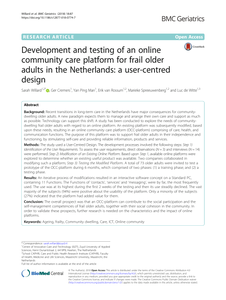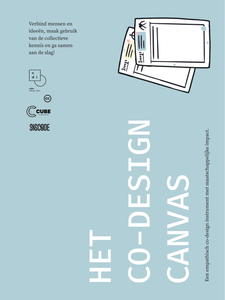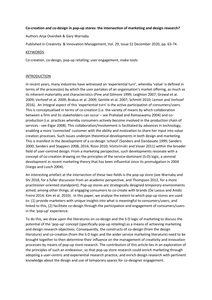Background: During the process of decision-making for long-term care, clients are often dependent on informal support and available information about quality ratings of care services. However, clients do not take ratings into account when considering preferred care, and need assistance to understand their preferences. A tool to elicit preferences for long-term care could be beneficial. Therefore, the aim of this qualitative descriptive study is to understand the user requirements and develop a web-based preference elicitation tool for clients in need of longterm care. Methods: We applied a user-centred design in which end-users influence the development of the tool. The included end-users were clients, relatives, and healthcare professionals. Data collection took place between November 2017 and March 2018 by means of meetings with the development team consisting of four users, walkthrough interviews with 21 individual users, video-audio recordings, field notes, and observations during the use of the tool. Data were collected during three phases of iteration: Look and feel, Navigation, and Content. A deductive and inductive content analysis approach was used for data analysis. Results: The layout was considered accessible and easy during the Look and feel phase, and users asked for neutral images. Users found navigation easy, and expressed the need for concise and shorter text blocks. Users reached consensus about the categories of preferences, wished to adjust the content with propositions about well-being, and discussed linguistic difficulties. Conclusion: By incorporating the requirements of end-users, the user-centred design proved to be useful in progressing from the prototype to the finalized tool ‘What matters to me’. This tool may assist the elicitation of client’s preferences in their search for long-term care.
DOCUMENT

Introduction: Sensor-feedback systems can be used to support people after stroke during independent practice of gait. The main aim of the study was to describe the user-centred approach to (re)design the user interface of the sensor feedback system “Stappy” for people after stroke, and share the deliverables and key observations from this process. Methods: The user-centred approach was structured around four phases (the discovery, definition, development and delivery phase) which were fundamental to the design process. Fifteen participants with cognitive and/or physical limitations participated (10 women, 2/3 older than 65). Prototypes were evaluated in multiple test rounds, consisting of 2–7 individual test sessions. Results: Seven deliverables were created: a list of design requirements, a personae, a user flow, a low-, medium- and high-fidelity prototype and the character “Stappy”. The first six deliverables were necessary tools to design the user interface, whereas the character was a solution resulting from this design process. Key observations related to “readability and contrast of visual information”, “understanding and remembering information”, “physical limitations” were confirmed by and “empathy” was additionally derived from the design process. Conclusions: The study offers a structured methodology resulting in deliverables and key observations, which can be used to (re)design meaningful user interfaces for people after stroke. Additionally, the study provides a technique that may promote “empathy” through the creation of the character Stappy. The description may provide guidance for health care professionals, researchers or designers in future user interface design projects in which existing products are redesigned for people after stroke.
DOCUMENT

Background: Recent transitions in long-term care in the Netherlands have major consequences for community- dwelling older adults. A new paradigm expects them to manage and arrange their own care and support as much as possible. Technology can support this shift. A study has been conducted to explore the needs of community- dwelling frail older adults with regard to an online platform. An existing platform was subsequently modified, based upon these needs, resulting in an online community care platform (OCC-platform) comprising of care, health, and communication functions. The purpose of this platform was to support frail older adults in their independence and functioning, by stimulating self-care and providing reliable information, products and services. Methods: The study used a User-Centred Design. The development processes involved the following steps: Step 1) Identification of the User Requirements. To assess the user requirements, direct observations (N = 3) and interviews (N = 14) were performed. Step 2) Modification of an Existing Online Platform. Based upon Step 1, available online platforms were explored to determine whether an existing useful product was available. Two companies collaborated in modifying such a platform; Step 3) Testing the Modified Platform. A total of 73 older adults were invited to test a prototype of the OCC-platform during 6 months, which comprised of two phases: (1) a training phase; and (2) a testing phase. Results: An iterative process of modifications resulted in an interactive software concept on a Standard PC, containing 11 Functions. The Functions of ‘contacts’, ‘services’ and ‘messaging’, were by far, the most frequently used. The use was at its highest during the first 2 weeks of the testing and then its use steadily declined. The vast majority of the subjects (94%) were positive about the usability of the platform. Only a minority of the subjects (27%) indicated that the platform had added value for them. Conclusion: The overall prospect was that an OCC-platform can contribute to the social participation and the self-management competencies of frail older adults, together with their social cohesion in the community. In order to validate these prospects, further research is needed on the characteristics and the impact of online platforms.
MULTIFILE

Het Co-Design Canvas is een instrument om samenwerkingen rondom maatschappelijke uitdagingen met verschillende betrokkenen open en transparant te starten, plannen, uitvoeren en evalueren. Het biedt een hulpmiddel aan overheden, burgers, bedrijven, non-profitorganisaties, kennisinstellingen en andere belanghebbenden om helder te kunnen communiceren en samenwerken. Het maakt verschillen in belangen, kennis, ervaring en machtsverhoudingen inzichtelijk, staat vanaf het begin stil bij gewenste positieve impact en concrete resultaten en zorgt ervoor dat ieders stem echt gehoord wordt.
MULTIFILE

Academic design research often fails to contribute to design practice. This dissertation explores how design research collaborations can provide knowledge that design professionals will use in practice. The research shows that design professionals are not addressed as an important audience between the many audiences of collaborative research projects. The research provides insight in the learning process by design professionals in design research collaborations and it identifies opportunities for even more learning. It shows that design professionals can learn about more than designing, but also about application domains or project organization.
DOCUMENT

We need look no further than the use of email communication, mobile phones and cars to understand that technology has wide-ranging social consequences. What is more, designers are plainly not always aware of the social consequences of technology, despite practicing user-centred design. Email, for instance, was developed as an efficient mode of communication between two actors. As we all know, the introduction of email has fundamentally changed traditional business and office practices. These side effects were not identified until long after email was introduced. During recent years, designers have grown increasingly interested in these social aspects. Modern information technology, in particular, creates extensive possibilities to influence social behaviour. Persuasive technology has been developed to increase, e.g., environmental friendliness. Once a designer aims at defined social changes, the consequences of technology for practices become a responsibility, too. The present research is aimed at providing tools and methods to anticipate social consequences at an earlier stage of the design process. These consequences of technologies in social environments will be called social impacts. In order to be a meaningful concept for designers the characteristics of a particular technology that are responsible for social impacts must be identified. Social consequences of technologies have not been observed very thoroughly from a user-centred design point of view. Therefore, this thesis is aimed, not only at gaining knowledge about social impact, but also translating these insights into workable instruments for designers. This leads to the following research questions:1. What relations can be identified between social impacts and characteristics oftechnologies?2. How can a designer anticipate social impact?3. How can social impact be managed in design environments?
DOCUMENT

In this paper we explore the influence of the physical and social environment (the design space) son the formation of shared understanding in multidisciplinary design teams. We concentrate on the creative design meeting as a microenvironment for studying processes of design communication. Our applied research context entails the design of mixed physical–digital interactive systems supporting design meetings. Informed by theories of embodiment that have recently gained interest in cognitive science, we focus on the role of interactive “traces,” representational artifacts both created and used by participants as scaffolds for creating shared understanding. Our research through design approach resulted in two prototypes that form two concrete proposals of how the environment may scaffold shared understanding in design meetings. In several user studies we observed users working with our systems in natural contexts. Our analysis reveals how an ensemble of ongoing social as well as physical interactions, scaffolded by the interactive environment, grounds the formation of shared understanding in teams. We discuss implications for designing collaborative tools and for design communication theory in general.
MULTIFILE

Co-creation as a concept and process has been prominent in both marketing and design research over the past ten years. Referring respectively to the active collaboration of firms with their stakeholders in value creation, or to the participation of design users in the design research process, there has arguably been little common discourse between these academic disciplines. This article seeks to redress this deficiency by connecting marketing and design research together—and particularly the concepts of co-creation and co-design—to advance theory and broaden the scope of applied research into the topic. It does this by elaborating the notion of the pop-up store as temporary place of consumer/user engagement, to build common ground for theory and experimentation in terms of allowing marketers insight into what is meaningful to consumers and in terms of facilitating co-design. The article describes two case studies, which outline how this can occur and concludes by proposing principles and an agenda for future marketing/design pop-up research. This is the peer reviewed version of the following article: Overdiek A. & Warnaby G. (2020), "Co-creation and co-design in pop-up stores: the intersection of marketing and design research?", Creativity & Innovation Management, Vol. 29, Issue S1, pp. 63-74, which has been published in final form at https://doi.org/10.1111/caim.12373. This article may be used for non-commercial purposes in accordance with Wiley Terms and Conditions for Use of Self-Archived Versions. LinkedIn: https://nl.linkedin.com/in/overdiek12345
MULTIFILE

Service design is literally the design of services. Service designers improve existing services or design completely new ones. Nothing new so far. Services have been around for centuries, and every service was conceived and designed by someone. However, service design takes a different angle; a different perspective as its starting point: it is a process of creative inquiry aimed at the experiences of the individual user. ‘Service design, insights from 9 case studies’ is the final publication of the Innovation in Services programme. During this programme, creative design agencies applied the methods of service design in nine different projects.
DOCUMENT

Primary school design is balancing between end-user needs and societal interests, and between traditional and innovative approaches. In current approaches, an unbalance affects end-users’ performances and obstructs innovative school-building design. The institutional system of design should not only be more aware of adjusting the quality design indicators to end-users, but they should actually do it in combination with the increasing need for more innovation in school-building designs. Present guidelines emphasize objective rational societal and traditional interests but underestimate the subjective essences of individual end-user needs and the abilities of intelligent school buildings to meet important requirements for present and future learning environments. Based on universal human needs and dynamic mechanisms relationships, this article addresses a number of reasons that cause these mismatches. We present a theoretical analysis to establish Needs Centred Guidelines for primary school design as a methodological tool to improve the balance between the societal and end-users’ needs, and to give more insight into underlying patterns in design processes. The guidelines are based on a variety of end-user psychological, physiological and bio-physical needs. This article explains how this analytic approach contributes to the attention for end-user physical learning environment needs and to innovate school design.
DOCUMENT